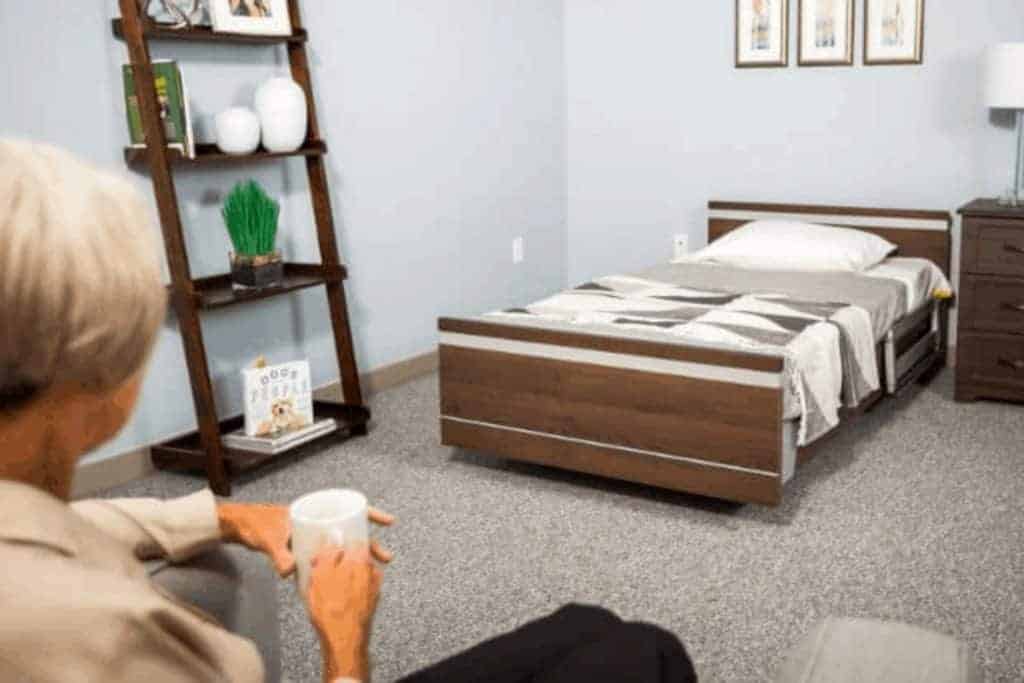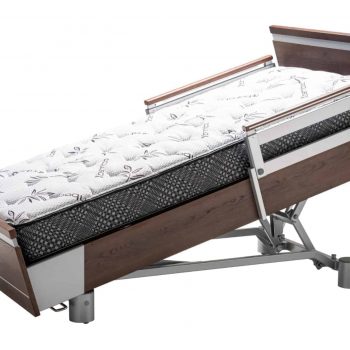

Hospital Beds
What Is The Trendelenburg Position?
Last Updated –
SonderCare Learning Center

SonderCare Learning Center
What Is The Trendelenburg Position? One feature of the SonderCare line of home hospital beds is the Tilt function. It allows users to take on what is known in the medical world as the Trendelenburg position. What is this position, and why do many of our clients need it?
Note: SonderCare is a healthcare equipment supplier; please ask your healthcare provider for any clinical or medical advice.
SonderCare Editorial Policy
All of our articles are written by a professional medical writer and edited for accuracy by a hospital bed expert. SonderCare is a Hospital Bed company with locations across the U.S. and Canada. We distribute, install and service our certified home hospital beds across North America. Our staff is made up of several hospital bed experts that have worked in the medical equipment industry for more than 20 years. Read more about our company here.
The Trendelenburg position places a person in a supine position (lying face up) on an incline between 15 and 30 degrees to get the legs higher than the head. A modified version of the technique only raises the legs.
The healthcare provider or user should minimize the degree of the Trendelenburg position as much as possible; if possible, the patient should be repositioned into the supine or reverse Trendelenburg position at established intervals.
The Anti-Trendelenburg position, also known as the Reverse-Trendelenburg position, involves placing the patient in the same position at an incline of between 15 and 30 degrees. In this case, though, the head is higher than the legs.
German surgeon Friedrich Trendelenburg invented the position; he used this method initially to improve the exposure of the pelvic organs during surgery. During World War I, doctors tried it for treating shock and hypotension, hoping it would increase blood perfusion to vital organs (this is now understood to be ineffective). In current surgical settings, the Trendelenburg position improves access to the pelvic organs by letting gravity move the patient’s abdominal organ towards the head.
In modern healthcare, doctors often turn to the Trendelenburg position for patients with respiratory issues. Raising the legs above the head may help improve the blood flow to the organs (called perfusion) in patients with respiratory illnesses. Healthcare professionals will also use it to increase respiratory function in overweight and obese patients by relieving pressure on the head.
Some users and healthcare providers believe resting in the Trendelenburg position for short periods will increase circulation and help the patient to relax. Users can also use the Anti-Trendelenburg position to improve circulation to the legs and feet.
Regardless of what they need it for, healthcare facilities and patients must have the correct equipment when using the Trendelenburg and Anti-Trendelenburg positions. Doctors and nurses use these features in medical facilities, but the beds can provide the same posture control and practicality at home, too.
Many doctors prescribe using one or both of these positions for their therapeutic benefits for congestive heart failure, edema, or other circulatory conditions. It’s believed that, in these healthcare cases, the patients must raise their legs above their heart for periods each day. If a physician prescribes this for an in-home patient, it’s good to have a hospital bed prepared to let them take on the position.
It could aid those who are dealing with issues related to restricted blood flow. A recent estimate suggests that 30 percent of seniors experience postural hypertension, causing a sudden and abrupt spike in blood pressure. It could lead to a person falling over due to this increase in blood pressure. The Trendelenburg position can allow patients to slowly raise and stabilize blood pressure before standing on their own.
By giving the user control over the bed’s Trendelenburg position, the tilting feature provides extra comfort and support for those who need a hospital bed. The Tilt feature may also be helpful for people who need their beds to sit up or raise their legs while in bed. Individuals with restricted mobility use the Trendelenburg position day-in-day-out to allow themselves to be comfortable. The Reverse-Trendelenburg position also helps patients with limited mobility sit right up in bed.
An electric hospital bed from SonderCare can also eliminate the need for manual tilting, which requires physical strength and can be very uncomfortable for patients and caregivers alike.
Lower abdominal operations such as colorectal, gynaecological, and gastrointestinal procedures, as well as central venous catheter implantation, are commonly performed in the Trendelenburg position. In a home setting it can be used to take pressure of critical areas and stimulate bloodflow.
A supine posture with the patient tilted at a 45-degree inclination, such that the pelvis is higher than the head, used both during pelvic surgery or for shock. Also, some practitioners recommend it for therapeutic benefits.
Henderson’s Maneuver is a similar technique used in emergency medicine and anesthesia to assist with the management of a patient’s airway and cardiac output. The maneuver involves placing the patient in a left lateral decubitus position, with the left arm extended above the head. This position is believed to improve venous return and pulmonary function, potentially enhancing resuscitation efforts. While the Henderson Maneuver has been widely used in the past, its effectiveness has been the subject of debate and further research is needed to determine its true utility in clinical practice. It is important for healthcare providers to carefully assess each patient’s individual needs and use a combination of evidence-based interventions to provide the best possible care.
This is used for a variety of purposes, including the treatment of pulmonary embolism. When the trendelenburg position is used, gravity pulls blood from the lower half of the body towards the head and chest, which can help to improve circulation and oxygenation. The trendelenburg position is also sometimes used as a position to improve surgical access, particularly during laparoscopic procedures. In these cases, shoulder braces may be used to help support the patient and prevent brachial plexus injury. A modified trendelenburg position, known as the steep trendelenburg, may also be used in certain situations. This position is used to increase venous return and is often used in conjunction with other treatments. It is important for healthcare providers to carefully consider the risks and benefits of the trendelenburg position before using it as a treatment option.
This position was first described by Friedrich Trendelenburg, a German surgeon, in 1844 and has been used for a variety of purposes over the years. One common use of the trendelenburg position is as a treatment for shock, particularly hypovolaemic shock. When the patient is in the trendelenburg position, gravity pulls the intra-abdominal organs towards the feet, which can help to improve circulation and oxygenation. The trendelenburg position may also be used in conjunction with passive leg raising, a technique in which the legs are elevated above the head. This position is thought to increase venous return and improve hemodynamics. While the trendelenburg position has been widely used, some studies have questioned its effectiveness and have not been able to support its use in all cases. The position is also used for laparoscopic surgery, as it can help to increase surgical access by pulling the intra-abdominal organs away from the operative site.
Patients are placed in a Trendelenburg position when their feet are higher than their heads, which is a medical position. Original use of this position was for treating hypotension; its effect may increase systolic blood pressure by improving venous return. By using a special bed or table, a patient can be placed in the trendelenburg position by elevating their feet. A shoulder brace may be used to maintain the patient’s position and prevent injury. During head and neck surgeries, the trendelenburg position also improves surgical access. This position can increase intracranial pressure and enable better exposure of the surgical site in these cases. In patients who are not intubated, the trendelenburg position should be used with caution due to its increased risk of air embolism. The trendelenburg position may be useful for treating low cardiac output, although its effectiveness in this regard is still debated, according to some studies.
An early proponent was Walter Cannon in the early 20th century, who believed that it could improve organ perfusion and increase blood pressure. However, later in his career, Cannon reversed his opinion on the trendelenburg position and stated that it was of limited value in the treatment of shock. Despite Cannon’s change of heart, the trendelenburg position remains in use today, although its effectiveness is still the subject of debate. One common use of the trendelenburg position is to improve surgical exposure of the pelvic organs. When the patient is in the trendelenburg position, gravity pulls the pelvic organs towards the feet, which can allow surgeons to better access and visualise the area. Some studies have found that the trendelenburg position can also help to visualise the inferior trabecular meshwork during ocular surgery. However, the risk of air embolism and other complications may deter its widespread use in clinical practice.
This is still a common way to increase venous return, increase cardiac output, and improve organ perfusion. The position has been used in a variety of clinical settings, including laparoscopic surgeries such as gallbladder removal. However, the effectiveness of the trendelenburg position has been the subject of debate over the years. In the 1920s, American physiologist Walter Cannon reversed his opinion on the position, stating that it was of limited value in the treatment of shock. Despite Cannon’s change of heart, the trendelenburg position remains in use today, although it is not always used as a primary treatment option.
Start Exploring Hospital Beds With SonderCare
Are you recently discharged from hospital, experiencing mobility issues, or in need of palliative or senior care? Enjoy a smoother recovery and get the luxury you deserve by choosing our home hospital products. Contact us today to discuss home hospital beds, mattresses, stand assist chairs and other accessories to make your home hospice perfect for a truly comfortable experience.
Are you looking for the most recent articles on buying hospital beds? Browse our latest resources below and let us know if you have any questions. We’re here to support you as you embark on your road to home medical care.
Seeking The Best Care For Your Loved One?
Browse North America's Luxury
Home Medical Supplies
Inventory